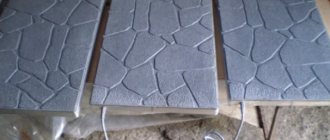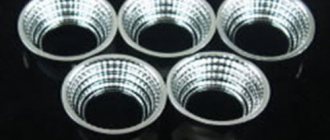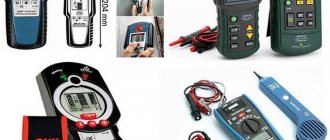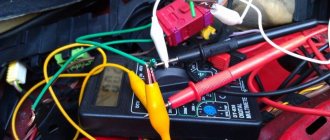During the renovation process, you have to remove partitions, break down walls, or move sockets and switches. It's not an easy job. Electrical cables are laid inside the walls under the plaster, and if done incorrectly, an accident can occur. Even the usual installation of bookshelves is dangerous without first locating the cable locations. Having wiring diagrams, you cannot be sure that they correspond to reality, because the previous owner could independently change the wiring without noting this in the diagram.
That is why it is necessary to determine the location of the cables. Nowadays there are quite a lot of devices on sale for detecting hidden electrical wiring, but sometimes the price is steep. Sometimes it’s better to use ready-made hidden wiring finder diagrams and do everything yourself, getting the device you need on your household.
The simplest indicator
The first option is the simplest indicator of hidden wires. Necessary materials for making it yourself:
magnetic circuit (a metal rod rolled into a circle, but with a break);- wire for winding onto a transformer with a resistance of about 500 Ohms;
- microphone cable with connector;
- radio receiver with microphone input.
We wind the wire onto the magnetic circuit, solder the ends to the cable, insulate it, insert the connector into the microphone input and the hidden wiring finder is made with your own hands in about half an hour. Turn on the maximum volume and move the coil along the search surface. Based on the change in sound, we find the location of the hidden cable.
DIY LED voltage indicator: diagrams with description
LEDs have long been used in any technology due to their low consumption, compactness and high reliability as a visual display of system operation. An LED voltage indicator is a useful device needed by amateurs and professionals to work with electricity. The principle is used in the illumination of wall switches and switches in surge protectors, voltage indicators, and test screwdrivers. Such a device can be made with your own hands due to its relative primitiveness.
12 volt
The LED indicator circuit for determining the car's charge voltage contains 16 parts.
12 volt probe circuit.
The device has three voltage dividers: resistors, zener diodes and transistors. Their outputs are connected to a three-color LED.
Single transistor detector
The following scheme was developed by V. Ognev from Perm. The finder uses a feature of a field-effect transistor; it is very sensitive to the slightest interference. When aiming at its gate, the channel resistance changes. This causes a large change in the current flowing through the phone, resulting in a change in sound. The phone must be high-resistance with a resistance of 1600-2200 Ohms, the battery must have a voltage of 1.5 - 4.5 volts, the polarity of its connection does not matter.
When searching for hidden wiring, the device is moved along the wall and the location of the wire is determined by the sound power. Instead of a telephone, you can use an ohmmeter with a built-in power source, then a battery is not needed.
The simplest scheme
This is the simplest scheme, so we’ll talk about it first, and explain all the little things in more detail (let those who understand not laugh). Anyone can collect it if they want.
For implementation we need:
- field effect transistor type KP 103 or KP 303 (designated VT);
- power supply 1.5-5 V (one or more batteries);
- electromagnetic telephone (designated SP);
- wires;
- any switch or toggle switch;
- an ohmmeter (designated Ω) or an avometer (tester), although you can do without it.
The only tools you need are a soldering iron and wire cutters. For soldering, naturally, you must have solder, flux or rosin. Now let's talk more about the unclear details.
Field-effect transistor
The most important detail, in the diagram it is indicated like this:
Structure and designation of field-effect transistor
We look at the right side of the figure, the left is not important to us, its conclusions are indicated by letters:
- “Z” - shutter (the direction of the arrow indicates type p or n; we also do not take this into account now;
- “I” is the source;
- "C" - stock.
If no voltage is applied to the gate of the transistor, then there is a large resistance between the source and drain, and almost no current flows. Having applied voltage, we open the gate and reduce the resistance (like opening a tap on a pipe), the current begins to flow. Moreover, field-effect transistors are very sensitive; the hidden wiring detector circuit is based on this feature.
This is what this part looks like in the photo.
Transistor KP103 in a metal case
Transistor KP 303 has the same appearance, but differs in marking. After the numbers there is also a letter designation, we do not take it into account. A second version is available in a plastic case in the form of a prism and three flat terminals at the bottom.
How the pins are located on the body should be clear from the figure below. On it, a transistor in a metal case is depicted with the terminals down; you need to navigate by the key.
This is how the pins are located on the body
Attention. Field-effect transistors can burn out from electrostatic interference. Therefore, when working, it is advisable to ground the soldering iron and your body (using a metal bracelet and wire).
Electromagnetic telephone
This is not a telephone device, but only a part of it (the device got its name from here), it looks like this:
Electromagnetic telephone
They come with a body made entirely of plastic. Suitable for old rotary phones. It is located in the tube in the part that is adjacent to the ear (from which we hear the interlocutor). In order to remove the phone, you need to unscrew the decorative cover and disconnect the wires at the terminals.
Handset
The marking is not important to us except the resistance, it should be in the range of 1600 - 2200 Ohms (can be designated Ω).
The phone works on the following principle - there is an electromagnet inside, which, when current flows through it, attracts a metal membrane. Vibrations of the membrane create the sound we hear.
Ohmmeter
This is a measuring device for determining resistance.
It looks like this:
Ohmmeter
If it’s difficult to find, then we’ll do without it, the scheme will work just like that. If necessary, you can draw conclusions for connection and use a “tester” (avometer or multimeter - the same thing) during the search in resistance measurement mode. Almost everyone has this device.
Advice. A simple field-effect transistor with clamped terminals (drain and source) in the crocodiles on the avometer probes can serve as an “ersatz finder” for hidden wiring. The Avometer naturally works in resistance measurement mode.
Avometer or "tester"
Assembling the circuit
All you need for assembly is a soldering iron.
We assemble all the parts using a canopy using wires according to the diagram. We solder a piece of single-core wire 5-10 centimeters long onto the transistor gate. It will act as an antenna.
After assembly, you can pack everything into any suitable case, such as a plastic soap dish.
The soap dish can serve as a housing
Looking for wiring
We bring the device turned on to the wall and begin to move the antenna along it. In the place where the live wire is located, a humming noise grows from the phone (like a working transformer). The closer to the wire, the stronger the sound will be.
You can more accurately find the wiring using the ohmmeter readings; when approached, it shows the least resistance. To work with an ohmmeter, turn off the power to the device.
How the device works
The whole point (as we have already said) is the high sensitivity of the field-effect transistor. The electromagnetic field induced on its gate with the antenna opens the transistor. Current is applied to the phone, and it begins to emit sound signals at a frequency of 50 Hertz (alternating current frequency).
An ohmmeter measures the resistance between source and drain. It becomes smaller as the gate signal increases.
Now let's look at more complex devices, without going too deep into the details.
Detector with three transistors
The device for detecting wiring is made on the basis of three transistors, two bipolar KP315B and one field-effect KP103D. A multivibrator is assembled on KP315B, and an electronic switch is assembled on KP103D. The schematic diagram of the hidden wire detector was developed by A. Borisov.
The principle of operation is the same as in the second option, only instead of a telephone a multivibrator with light indication is used. When the detector is turned on and there is no pickup on the antenna probe, the LED does not light up. When radiation appears in the area of the probe, the field-effect transistor closes, thereby triggering the multivibrator and the LED begins to flicker, indicating the presence of electrical wiring.
Parts used in accordance with the diagram, push-button switch – KM-1, power source – any battery or accumulator with a voltage of 6-9 volts.
You can use a plastic soap dish or a school pencil case as the finder body. The blinking frequency of the LED can be adjusted by changing the characteristics of the multivibrator, changing the values of resistances R3, R5 or capacitors C1, C2.
Necessary materials for making an indicator
To make a simple LED device that indicates phase or voltage (approximately), you need to find a working circuit. Then buy or obtain the following parts and tools:
- LED of any type;
- a diode opening with a current of 10-100 mA at a forward potential of 1 V, with a breakdown voltage (reverse) of at least 30-75 V;
- resistor 100-200 kOhm;
- bipolar transistors;
- soldering iron;
- wires;
- metal plate (can be cut from a beer can);
- plastic case, preferably transparent;
- sting, you can take a regular nail.
Chinese soldering iron with USB charging.
Electrical wiring detector on two digital chips
The hidden wiring finder circuit developed by G. Zhidovkin is very simple.
Composition: 2 digital microcircuits, piezoceramic emitter ZP-3 and 9 V battery. The role of the antenna is played by a piece of copper wire 10-15 cm long and 1-2 mm in diameter.
Induced oscillations from the electromagnetic field of the wiring lead to a change in the output signal of the K561LA7, which is supplied to the input of the K561TL1 with Schmitt triggers. As a result, a characteristic cracking sound is heard, signaling the presence of a cable.
Device based on K561TL1
Unlike the previous version, the wiring finder based on K561TL1, in addition to an audible alarm, has a light indication.
The essence of the work is as follows. When the antenna is brought close to a live wire, an electromotive force with a frequency of 50 Hz is induced in it. This signal goes to the operational amplifier, then to the LED and the input of the K561TL1 microcircuit with a piezoceramic emitter at the output. This causes the audio frequency generator to start and the LED to flicker.
The finder is economical, the maximum current with the indicator on is 6-7 mA.
The antenna is made of one-sided foil fiberglass laminate measuring 55x12 mm. The initial sensitivity is set by variable resistor R2. If installed correctly, the device, developed by S. Stakhov (Kazan), does not require adjustment.
Universal Wiring Detector
You can make a universal hidden wiring indicator with your own hands, provided that you have some skills in drawing up radio circuits.
The finder contains two independent units: a finder for hidden live wiring and a metal detector. This allows you to detect electrical wiring when it is laid in steel sleeves or when there is no voltage in the network. Additionally, the detector searches for and finds old de-energized wiring, fittings, nails and other metal objects.
The detector is based on two operational amplifiers KR140UD1208. The hidden wiring detector unit is practically the same as the previous device, only without an audible warning.
The metal detector unit works as follows.
A high-frequency generator is assembled on the KT315 transistor, which is put into excitation mode using variable resistance R6. The output signal of the generator is rectified by the KD522 diode and puts the comparator assembled on the KR140UD1208OU operational amplifier into a state where the audio signal generator assembled on the K561LE5 digital chip is in standby mode and the LED goes out.
By rotating the variable resistance R6, the operating mode of the KT315 transistor is changed so that it is at the generation threshold. The status is monitored using a light indicator and a sound signal generator. They should switch off. To detect hidden wiring, you need to bring the device to the wall, when the antenna (inductors L1, L2) comes close to the metal, the magnetic field changes, generation is disrupted, the comparator starts up, and the LED lights up. The piezo emitter begins to emit sound with a frequency of 1 KHz.
DIY hidden wiring detectors
Varieties and schemes of indicators. Searching for wires using the emitted electromagnetic field, detecting breaks and damage in car wiring, telephone and computer networks.An experienced electrician knows that all wires are divided into two categories: “Like this one” and “Oh, your mother.” Therefore, if you need to pick up a hammer drill and drill a hole in the wall, it is advisable to make sure that there is no wiring, fittings, pipes or other metal in this place. Guessing the position of the wires using only common sense is a thankless task and extremely unpromising. Consequently, a device called a “ hidden wiring indicator ”, also known as a detector , also known as a signaling device , as well as a tester, identifier, finder, etc. of cable routes, would be at all useful in the household.
The simplest in principle of operation and implementation are devices that search for electrical wires based on the 50-Hz electromagnetic field emitted by them (the wires). It is clear that for correct detection, the desired piece of iron must be under voltage, moreover, under alternating voltage. At the same time, the most common of this type of detectors are devices with a sensor of the electric component of the field , and specifically with a short metal pin. Quite a large number of similar simple devices listed on the network suffer from two significant flaws: either weak sensitivity, or not weak sensitivity, but poor noise immunity, which does not make it possible to obtain the expected (aka accurate) result. Therefore, as an illustration, I will give a circuit of the Cicada - 1M hidden wiring detector, tested and approved by participants in the forum debates, authored by Eduard.
Fig. 1 Diagram of the hidden wiring detector "Cicada - 1M"
The input amplifier stage on a field-effect transistor is connected in a similar way to the factory device of the wiring detector "Dyatel E-121". At DD1.3, DD1.4 an audio frequency generator is assembled, loaded onto a ZP-3 capsule and triggered when the level of the amplified input signal exceeds the response threshold of element DD1.1. Simultaneously with the start of the generator, the LED connected to the output of the inverter DD1.2 lights up.
Here is what the author of the above diagram writes: “The device sees approximately 30...50 mm in the wall. Much depends on the intensity of the current in the conductor, on the material of the walls, etc. In addition, electricians say that you need to get used to any such device. I am writing an article because such a device is a very convenient, useful and easy-to-assemble design that will be useful to any home craftsman. As a sound emitter, you can use any piezoceramic emitter such as ZP-3, ZP-1, etc. I decided to make the antenna not from copper wire, but from a piece of television coaxial cable, connecting the central core and the screen. I liked that it was tough but flexible. The device works even without a load on the network; it does not pick up the fittings. When the load is turned on, the field becomes more intense, and the more powerful the load, the more energetically the Cicada coos.”
A detector circuit for detecting hidden wiring was constructed in a similar way, published in the journal Radio, 1997, No. 3, p. 44. Its advantage over the previous development is the ability to adjust sensitivity.
Fig. 2 Diagram of a device for searching hidden electrical wiring
The original source in the form of the author of the article, E. Stakhova, writes: “I would like to add my own version of a device for searching for hidden electrical wiring, the operation of which has been tested many times. The device diagram is shown in Fig. 2. It consists of two components - an AC voltage amplifier, the basis of which is the micro-power operational amplifier DA1, and an audio frequency oscillation generator assembled on an inverting Schmitt trigger DD1.1 of the K561TL1 microcircuit, a frequency-setting circuit R7C2 and a piezo emitter BF1. When the WA1 antenna is located near the current-carrying wire of the power supply network, the pickup of the EMF at an industrial frequency of 50 Hz is amplified by the DA1 microcircuit, as a result of which the HL1 LED lights up. The same output voltage of the operational amplifier, pulsating at a frequency of 50 Hz, starts the AF generator. The current consumed by the device microcircuits when powered from a 9 V source does not exceed 2 mA, and when the HL1 LED is turned on - 6...7 mA. The power source can be a 7D-0.126 battery, “Korund” or a similar one made abroad. The circuit board is placed in a housing made of dielectric material so that the antenna is in the head part and is as far as possible from the operator’s hand. The initial sensitivity of the device is set using trimming resistor R2.”
with a sensor for the magnetic component of the field wires have somewhat better characteristics (in terms of noise immunity) . As magnetic field sensors, you can use a wide range of winding products, such as: a tape head, a winding of a low-current relay, a matching or output transformer from an old radio, a high-impedance earphone (type Tone-2, 1600 Ohm), and simply - independently wound on a ferrite the rod is a coil with an inductance of several hundred millihenries. In its simplest form, such a detector can be: a magnetic sensor, a sensor signal amplifier, plus headphones that record the background emitted by the wiring (Fig. 3).
Fig.3 Diagram of a hidden wiring detector with a magnetic field sensor
Here are a few comments about this device, collected bit by bit on the pages of the forum www.radiokot.ru.
Grishanenko: “The sensitivity is very good. A 100-W power transformer (virtually at idle) inside the amplifier produces pickup over 1.5 meters. Wires inside reinforced concrete slabs can also be heard. Under plaster no problem at all. It’s clear that you can’t find a broken cable, but if the main task is not to drill the wire, then it’s quite enough.”
serpa: “I assembled the device according to the diagram without any modifications. The sensor - trans from the RUSSIYA RP-203.1 receiver was located at the output of the amplifier to the speaker. On the trance there is only the inscription TS. This scheme works MUCH better than with KP103, although you need to load the wiring (turn on the load). But there are no extraneous noises. 50Hz is clearly audible in headphones.”
igor72: “My walls are brick, reinforced, the simplest finder on a field detector was found all over the wall. I soldered this device, set the opamp to 140ud1208. I tried the TP-12 transformer from the VEF receiver and a high-impedance earphone (Ton-2, 1600 Ohm). It works with both, but I liked the earphone better - the signal is quieter, but only in the right places, and with a transformer there is a constant background that slightly changes the frequency when connected to the wiring. And I prefer something that works only with a loaded line - it’s easy to understand the route of laying a specific line. A small minus is that for some reason the water supply and heating pipes are also leaking.”
In the event that the network (or any other) lines are de-energized, then due to the lack of a field, the described detectors completely lose their relevance. Although there is a way to get out of this situation, namely, to apply a signal from an external generator to the line under test. Let us present a diagram of such a generator, extracted from the documentation for the industrial cable tester-router Mastech MS6812.
Fig. 4 Schematic of the Mastech MS6812 cable tester-router generator
Let's start with the fact that (intentionally or through negligence) the polarities of all diodes except the LED in the diagram are indicated incorrectly - they must be reversed. The generator produces at its output a rectangular alternating voltage with a frequency of about 1500 Hz, generated by inverters DA1.5 and DA1.6, which is modulated by a low-frequency generator (DA1.1 and DA1.2) with an oscillation frequency of about 3...4 Hz. DA1.3 and DA1.4 are the output buffer stage. When connected to the line under test, such a generator, together with the detectors described above, allows the following manipulations: tracing the cable route, testing the cable for breaks, detecting the location of the break, searching for damage in car wiring, telephone and computer networks.
Another way to find a de-energized piece of hardware inside a wall is with metal detector indicators . Such devices will give a signal about any metal objects, be it a wire, a screw, a nail, a pipe or a piece of fittings. In some cases, this can significantly complicate the process of searching for wiring, on the other hand, it allows you to avoid troubles associated with the elimination of all communications and crushing equipment. The principle of operation and design of such indicators are completely similar to those in metal detectors designed to search for all kinds of pieces of iron, be it in sand, water, a suitcase or other clay formations. We examined such devices in detail on the page: Metal detectors, operating principles and diagrams.
Small metal detector
The detector is designed to search for hidden wiring, fittings and other metal objects.
The main difference from previous models is that you do not need to wind the inductors yourself. Instead, a relay coil is used. The work of the finder is based on the task of isolating the difference frequency of two generators, when, when approaching a metal object, one search generator (LC) changes its oscillation frequency.
The metal detector includes LC and RC generators, a buffer stage, a mixer, a comparator and an output stage.
The frequencies of the RC and LC generators are selected to be approximately the same, then, after passing through the mixer, the output will already have three frequencies. The third is equal to the difference between the frequencies of the RC and LC circuits.
The low-pass filter subtracts the difference frequency and sends the signal to the comparator, where a square wave of the same frequency is formed.
From the output element, the meander goes through capacitance C5 to the telephone, whose resistance should be approximately 0.1 KOhm. Since the capacitance and active resistance of the telephone form a differentiating RC circuit, an impulse will be formed during the rise and fall of the meander. As a result, a person will hear clicks with a frequency twice the difference.
Detection of hidden wiring will be detected by a change in sound frequency. The coil is taken from the RES 9 relay, and the moving elements are removed. Since the relay contains 2 coils with different cores, the common terminals of the windings must be connected to capacitance C1, and the core and variable resistance housing must be connected to a common bus.
Double-sided foil getinax or fiberglass is used as a printed circuit board. The finder parts should be placed on one side; the other side does not need to be etched, it must be connected to the common bus of the device.
A battery and an inductor from a relay are attached to the second side.
The board is installed in any non-metallic case where the phone connector is attached. Setting up a metal detector begins with adjusting the frequency of the LC generator by selecting capacitance C1. The frequency should be in the range of 60-90 kHz.
Then we change the capacitance of capacitor C2 until sound appears in the phone. When adjusting the resistance in different directions, the sound should change.
Depending on the setting, the frequency will change and the detector will make a sound as if searching for a radio station. The closer the metal, the louder the sound. The tonality depends on the type of metal.
Kinds
Wiring detection devices differ depending on their operating principle. The simplest option is considered to be electrostatic detectors, which determine the location of live wires. Such devices detect electromagnetic waves, but are sensitive to interference created by third-party household devices.
The most common type is electromagnetic finders. They detect live wires, provided that the load on the network is at least 1 kW. The key advantage of such devices is high accuracy. The cable location can be determined with an error of 2–3 mm.
Metal detectors are often used as wiring indicators. These devices react to metal objects, including live wires. They can also be used to locate metal fittings, locate pipes, or identify stuck fasteners.
There are also universal indicators. They use several verification options simultaneously. These devices are used in construction, during installation work and in the design of buildings.
Non-standard methods
Finally, it’s worth describing a couple of unusual devices for finding hidden wiring, which can be done even by people who have no knowledge of electronics. If the house has a regular compass, then this is a ready-made wiring indicator. Before use, the wiring should be thoroughly loaded, and look for the location of the wire by the deviation of the compass needle.
The second method is more effective; the force of a magnet is also used. A permanent magnet, preferably neodymium, is attached to a piece of thread and slowly drawn along the wall. Where the cable or fittings pass, the magnet will deflect. This happens due to the generation of magnetic current by electric current. This is how basic knowledge of the physics of magnetic phenomena helps to find hidden wires.
Testing homemade hidden wiring alarms
Before using homemade products, it is necessary to test hidden wiring detectors. It will show if the device is working properly. Testing order:
- Find an area where 100% hidden wiring runs (sockets and switches);
- Test your homemade alarm by running it along the wall around the outlet;
- If the signal is received only at the place where the cable passes, you can use the device;
- If the signal appears and disappears in different directions from the outlet, then the device does not work.
Attention! Before searching for hidden wiring, give it maximum load. To do this, include as many electrical appliances as possible. This will help strengthen the electric and magnetic fields that the testers respond to.
To make sure you don’t hit a cable hidden by a wall with a hammer drill or a nail, you need to become familiar with the wiring diagram in your apartment. But often it gets lost, and finding the wires becomes difficult. However, with the help of a homemade electrical wiring detector, you will accurately determine the place where you can hang a shelf or picture. You don’t need to rush to the store for this: you will find all the elements at home in old electronics.











